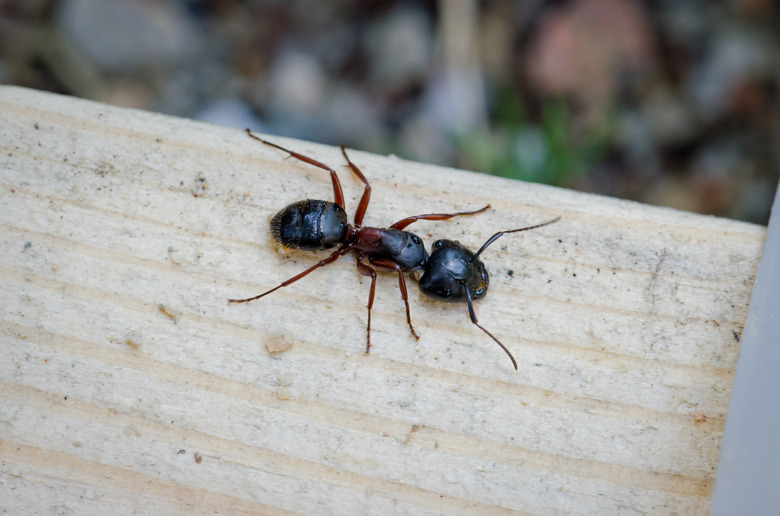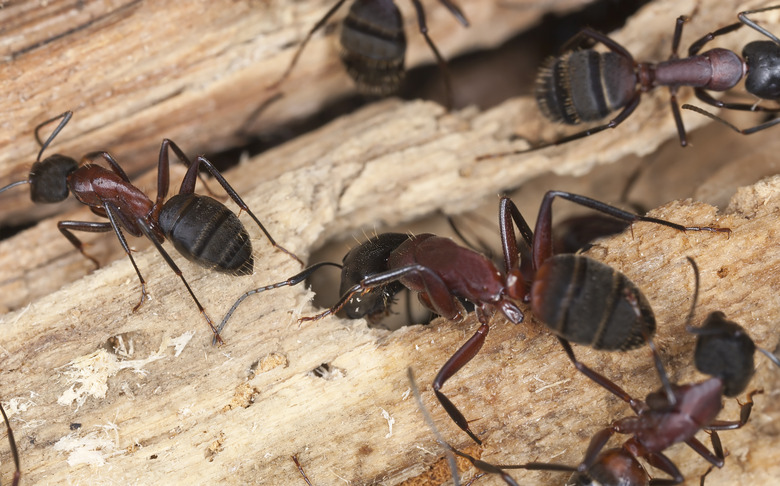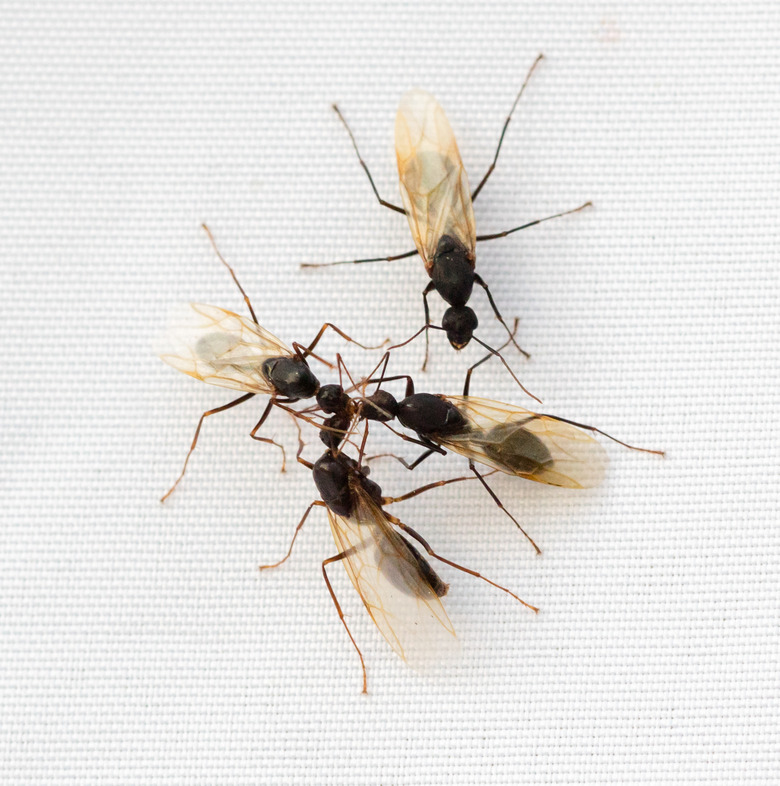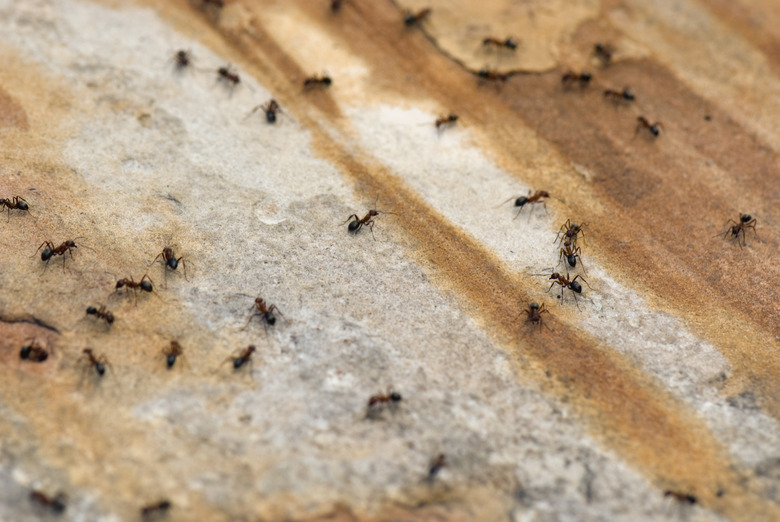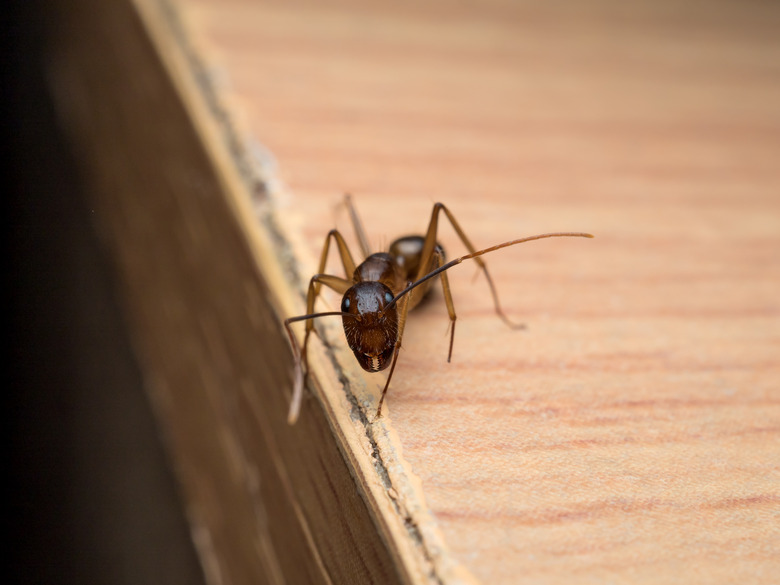How To Get Rid Of Carpenter Ants
We may receive a commission on purchases made from links.
Carpenter ants may be tiny in stature, but their nests — and the damage they cause — can be quite massive. A carpenter ant nest may contain as many as 2,000 to 3,000 adult ants, and although you would think the damage they cause would be immediately apparent, it's not. Carpenter ants (Camponotus spp.) work below the surface of the wood, creating a maze of tunnels. These tunnels weaken the wood, and over time, this can lead to structural damage and a real headache for homeowners.
Carpenter ants like to establish colonies in moist wood that may already be damaged in some way, but a carpenter ant nest can also be found in sound lumber. Places to look for them include door and window frames; baseboards; the posts, floors, and ceilings of porches; wood siding; and any area that is prone to moisture damage. You can also find a carpenter ant nest outdoors in tree stumps, fallen logs, and fence posts.
The most important part of eliminating a colony of carpenter ants is to find the nest. A nest contains thousands of worker ants in various stages of development and one queen. Eliminating the colony is sometimes a straightforward DIY project, but that is not always the case. Nests can be hard to find, and often, you will need to hire a pro to help you get rid of your ant problem. At a certain point, a large colony will develop satellite colonies made up of workers, and they must also be destroyed, or the infestation will continue.
What Do Carpenter Ants Look Like?
What Do Carpenter Ants Look Like?
- Species name: Camponotus spp. There are 24 species of carpenter ants in the United States. The most common is the black carpenter ant, C. pennsylvanicus.
- Physical characteristics: A typical mature worker carpenter ant is about 6 millimeters to 1/2 inch in length, making them among the largest ants, although there are species that are smaller. Not all workers in a colony are the same size. There are major and minor workers. The queen is larger than the workers and can be up to 1 inch long. Most carpenter ants are black, although there are also red carpenter ants and some that are a combination of red and black.
- Wings or wingless?: Both. The majority are wingless, but once the colony matures in three to six years, it produces winged carpenter ants called swarmers. Winged carpenter ants can be either male or female. They mate outside of the carpenter ant nest. The females may start nests of their own.
- How to tell carpenter ants from termites: People often confuse winged carpenter ants with termites. Carpenter ants are usually bigger than termites, and they have two sets of wings that are different sizes. Termites have one set. Winged carpenter ants have narrow waists, and their antennae are bent. Termites have thicker waists and straight antennae.
How to Get Rid of Carpenter Ants
How to Get Rid of Carpenter Ants
Seeing a few carpenter ants run across your kitchen counter may repulse you, but it does not necessarily mean you have a nest in your house. Carpenter ants can range as far as 100 yards in search of food. Unlike termites, carpenter ants do not eat the wood they excavate. In fact, the tunnels they create are very smooth and clean. Termite tunnels are usually filled with mud.
Here's a few tips on getting rid of carpenter ants in your home.
Don't Use Bug Spray
If you see carpenter ants inside your home, resist the temptation to stomp on them or spray them with bug spray. The ants you see are foragers looking for food sources, and spraying foragers with an insecticide won't help because the insects carry little of the insecticide back to the nest with them. Spraying may reduce the number of ants you see, but it won't eliminate the main problem. However, if you should uncover a nest during a remodeling project, using a spray insecticide may eliminate your problem.
Find the Nest
You need to locate the nest to rid your house of the colony. Place cotton balls dipped in a honey and water solution for baiting near where you saw the ants or use a commercial ant bait. The bait may attract many ants, which is good because it means the bait is working, so don't be alarmed.
Monitor the baits for a couple days. It is best to try and do this at night because carpenter ants are nocturnal. If it is not attracting a large number of ants, try another type of bait. Carpenter ants have been known to change their food preferences over time. Usually they feed on sugar, honeydew from aphids, dead insects, and dead animals.
Ants follow established trails, so you can follow them back to where they disappear behind woodwork or a cabinet on their way to the nest. Evidence of a carpenter ant nest includes a hollow sound when you tap on a section of wood with a small hammer or screwdriver. You may also see small piles of wood shavings and frass, which is the debris and excrement produced by the ants, near where their tunnels are located.
A busy colony can produce a faint rustling sound inside the walls. The sound will grow louder if you tap on the wood near their nest, and it agitates the ants.
Apply a Pesticide Treatment to the Nest
Once you have a general idea of their location, you can drill a series of 1/8-inch holes 3 to 6 feet on either side of where the ants disappeared and wearing a mask and gloves, apply an insecticide containing boric acid into the holes. The boric acid clings to the body of the ants. The ants will ingest the boric acid during grooming, and the material will eventually kill them.
Boric acid is a naturally occurring substance that is used in a variety of pesticides. It is safe for humans and pets, although some people may be allergic to the powder. The material is also used in fertilizers, soil amendments, household cleaning products, laundry detergents, and personal care products. Although it is safe, be sure to follow the directions of any pesticide you use.
Commercial baits often contain boric acid or some other insecticide, such as fipronil or spinosad. In these cases, the ants eat the bait and go back to the nest, where they regurgitate the bait and feed it to other members of the colony, including the queen.
Eliminating a nest can take several weeks, especially if there are satellite colonies because the poison has to make its way from the main nest to the satellite nest. In many cases, a treatment may kill most but not all of the colony. So, follow-up treatments are often necessary.
If you find a nest outdoors in an ornamental or fruit tree or rotting fence post, it makes sense to eliminate the colony. Foraging ants could find their way inside your home or even establish an entire colony there.
When to Hire a Pro
When to Hire a Pro
Getting rid of a carpenter ant colonies can be tricky, especially if you don't know for sure where the carpenter ant nest is located. That is when it is time to call in a professional pest control company.
Different companies will take different approaches to the problem. The best long-term solution is to find the nest and destroy the colony. Experience and special equipment will help them do their job. They also use commercial insecticides that are not available to the public. You can help by keeping track of where and when you see the ants.
Some companies may suggest setting up a schedule for spraying around the perimeter of the house. This will prevent outdoor ants from getting inside, but it won't be effective if there is a nest inside the house.
Because they are so tricky to eliminate, pest control companies often charge more for a carpenter ant infestation than they would for other types of ants. Expect to pay $200 to $500 for a single visit that includes hunting down the nest and destroying the colony. Additional spraying may be $100 to $150 per visit. The size of the area to be treated for carpenter ant control also affects the cost, as does the difficulty in locating the nest.
How Carpenter Ants Get In Your House
How Carpenter Ants Get In Your House
Carpenter ants can get into a house in two ways. Either a queen establishes a colony somewhere inside, or the colony is outside, but workers forage for food inside the house. Workers can also establish a satellite colony inside the house. Just about any opening is probably large enough for a carpenter ant to squeeze through, so sealing all entry points is difficult.
Once a queen establishes a nest, she will seal the nest and lay about 15 to 20 eggs. She will feed the developing larvae nutrients from her own body. Once the first generation reaches maturity, the nest is unsealed, and the mature workers begin foraging for food. The queen will lay eggs continuously, and the workers will take over feeding the larvae. The queen can live for up to 15 years, while workers live for about five years.
Carpenter ants are most active from midspring to midfall. They are usually dormant during the winter. If you see ants in your house in late winter or early spring, a colony may be inside the house. Also, if there are a lot of flying swarmers inside, a colony is probably inside the house. Seeing a few ants during the summer months can indicate that the nest is either inside or outside.
How to Prevent Carpenter Ants
How to Prevent Carpenter Ants
Carpenter ants like moist wood, so fix any leaks and the water damage they may have caused. Pay attention to areas where moisture can accumulate, such as around bathtubs and sinks. Move stacked firewood away from the house and keep it off the ground.
It is also a good idea to remove dead trees and tree stumps from your property. Prune or trim branches of trees or shrubs that overhang your roof. A colony established outside could move inside.
To help prevent ants from an outdoor nest moving inside, seal up holes and cracks in the foundation and siding of the home. You can also apply a granular product around the outside perimeter of the home as a barrier. These products are designed to prevent ants from entering, and they contain an insecticide to kill outdoor colonies.
Do Carpenter Ants Cause Damage?
Do Carpenter Ants Cause Damage?
Carpenter ants aren't known to spread diseases. Although they can bite, the bite isn't serious and is more of a nuisance. Carpenter ants tunnel through wood, and that is where they can cause damage, but it can take years before the nests lead to serious damage. However, if you do see the telltale wood shavings or see a lot of ants inside the house, it is best to take action before serious damage occurs.
These ants do damage trees. A study by Rutgers University found that 75 percent of the trees sampled were infested with carpenter ants. The infestations not only weaken the trees but can lead to infestations from other pests.
